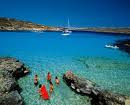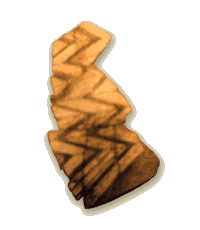Malta is a beautiful holiday island
and strategic importance. There are actually three islands. Malta, Comino and
Gozo and are in a narrow passage in the Mediterranean between Sicily and
Tunisia. The entire island has hills and a natural harbour. The harbours are
deep and make good ports.
The islands are of limestone. The
problem is that the stone is porous and it prevents the rivers flowing all year
round which doesn't help the farming industry. However, they do produce food
and when they have a good year they export the surplus.
The climate is hot in the summer and
sunny winters. This brings many tourists to the islands which is their main
part of the economy. Another source is the Valletta’s Grand Harbour which is
still shipbuilding and ship repairing. It used to be the British naval
dockyard. For many years, much of Malta's income came from the British Naval
base near Valletta. In 1979 the base was closed but they managed to keep the
yard going. The islands are also visited by yachts and cruisers touring the
Mediterranean.
Small factories, with raw material
imported, make clothing, shoes, plastics and electronics. They export it to
Germany, Italy and Britain.
The Maltese language is of Arabic
origin but mixed with many European words and it originated from a language
spoken 5000 years ago by the original inhabitants. Apart from that there is
also England and Italian spoken.

MALTA'S BEACHES AND COVES

GHAR DALAM TEMPLE

PREHISTORIC POTTER
HISTORY
Malta has been inhabited for a long
time. Temples were built by ancient civilisation at Mgarr and Skorba.
Pottery had been discovered from the
Ghar Dalam phase -- 5200 TO 4500 BC -- is very much like the pottery
found in Agrigento, Sicily. The culture is of megalithic temple building. The
megalithic Ggantija temples in Gozo are of the oldest free-standing structures
in the world. They are from about 3500 BC. The temples have a distinguished
architecture. They are built in a complex trefoil design.
Behind a removable altar were animals’
bones and a knife found. It is assumed that animals’ sacrifices have been made
to the Goddesses of fertility. The statue is to be seen in the National Museum
Valletta. It is not clear why this culture disappeared around 2500 BC.
Archaeologists assume it could be famine or diseases. It was also around the
same time of Pluto's account of the disappearance of Atlantis.
700 BC the Ancient Greeks settled in
Malta
A century later the Phoenician
travellers used the islands as a port between east Mediterranean to Cornwall.
Some even settled and started the city of Mdina. After the fall of the
Phoenicia in around 400 BC it was taken over by the Carthage.
It was during the First Punic War in
264 BC that the Maltese people turned to the Roman consul Sempronius and
remained loyal to Rome during the Second Punic War.
By 117 BC Malta was a thriving island
and part of the Roman Empire.
When Rome split into Eastern and
Western division in the 4th century, Malta became part of the Byzantine Empire
from 395 to 870. Not much is know about this period.
Later on the Arabs ruled Malta and
then the Normans and after that the Spaniards.
In 1530 the Knights of St John
arrived from Rhodos and built a fortress there. The Maltese Cross came from
this period. It prevented the advance of the Ottoman Empire. In 1565 the
Ottoman Turks held three cities and Mdina in the Great Siege. The Maltese
people and Knights did not surrender. Western Europe was grateful that the
continuous advancing Ottoman Empire had been stopped.
Napoleon invaded Malta in 1800 and
made the knights to leave but soon the British moved in and stayed till 1964..
In the Second World War the islander hands to defend themselves again when they
were besieged by the Italians and Germans. It was the only route in the
Mediterranean between British Gibraltar and Montgomery 8th Army. The islanders
held out for three years despite horrendous hardship. King George VI awarded
the whole nation a George Cross.
The British closed their bases and
the islander lost jobs. Malta then went on developing their own shipbuilding
industry and now they are successful in building and repairing. Also luxury
yachts and liners cruising the Mediterranean are calling in their ports
Since they became independent they
managed to overcome the closure of the British Navel base and the job losses.
After that Malta negotiated to join the European Union.
HOLIDAY ACTIVITIES
Malta is the biggest of the three
islands. A pictures island offers a great number to do. A wonderful coastline
with an abandons of caves, coves beautiful beaches gives plenty of water sports
and the best diving location in the Mediterranean.
Valletta has beautiful architectures
throughout the ages. There are buildings dating back to the times when the
Knights of St John of Jerusalem ruled in the 16th century. Also the remaining building
is mainly Barock and you can visit two magnificent Barock palaces. The city is
declared a World Heritage Site by UNESCO.
National Museums have Fine Art
painting by Turner and Pieto to name just two. Many Archaeology displays are
exceptional exhibits from Malta's prehistoric period which ranges from Ghar
Dalam 5200 BC to the Taxien 2500 BC.
The gardens were first constructed in
1661 for the Knights. The paths are lined with busts, statues and plaques.
A re-enacting of the time of the
siege by the Ottoman in 1565 can be seen at Fort Saint Elmo.
For the whole family -- children small,
big and very big -- there is the village of Popeye where the actual filming
took place.
POPEYE


POPEYE -- VILLAGES
As you can see Malta is a Holiday Island
you will never forget.

No comments:
Post a Comment